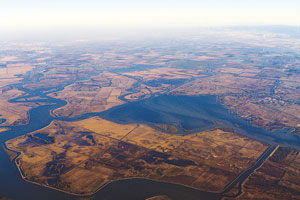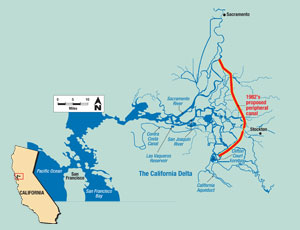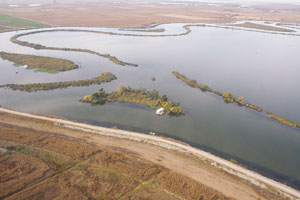A proposal to build a 42-mile long, 400-ft-wide water conveyance canal soundly rejected by California voters in 1982 is rising from the mists of the Sacramento-San Joaquin Delta again. It is driven this time, in large part, by a heightened appreciation for risk and the physical fragility of the state�s water supply. Consider it a legacy of Hurricane Katrina.



�Not long ago, risk was a dirty word, but things have changed,� says Martin W. McCann Jr., project technical director of the �Sacramento-San Joaquin Delta Risk Management Strategy� study, one of several concurrent studies analyzing water issues in the state. �Now, [risk] is becoming every man�s tool. But it�s a unique expertise. We need to find the balance in how and when to use it.�
McCann, who also is a dam safety expert and an associate professor at Stanford University, spoke on Nov. 7 about the DRMS study, a project of the state�s Dept. of Water Resources, at the American Society of Civil Engineers� 138th Civil Engineering Conference in Pittsburgh. He was part of a panel on risk-assessment evolution and expectations.
How experts define and plan for risk mitigation on infrastructure facilities is changing in the post-Katrina world. The emergence of new disciplines developed while studying and recovering from the disaster in New Orleans has led to techniques for evaluating the fragility of infrastructure and weighing that against the probability of failure and its consequences.
At the direction of Gov. Arnold Schwarzenegger (R), California launched at least four studies to attack the problem of its water supply and the protection of the ecosystems in the delta. The reports are coming in and are refocusing attention on the need for what is euphemistically called a �dual-conveyance� water delivery system. The first conveyance system is the waterways of the delta; the second is a revitalization of plans for a bypass, or peripheral canal.
One of the reports recently delivered to Schwarzenegger, that of the Delta Vision Blue Ribbon Task Force, says such a canal could help protect water quality and ecosystems in the delta, and with that, the state�s water supply. The canal would divert some 700,000 acre ft of river water per year around the fragile maze of islands and levees directly into the 400-mile-long California Aqueduct for delivery to Southern California. Construction would also include at least two new impoundment dams.
Voters rejected that plan by a 62% to 38% margin in 1982 over objections to its $3.1-billion cost, in 1981 dollars, and over concerns about negative consequences to the delta�s ecology. But in that debate, the risk of a catastrophic failure of the bulk of the state�s water supply was not often mentioned. This time, although cost and environmental concerns still loom large, risk is expected to play a much larger role in the debate.
The Sacramento-San Joaquin Delta is a maze of tributaries, sloughs, wetlands and islands through which drain two of the largest rivers in the state. Seventy-two islands are clustered within the lacework of freshwater channels, and therein lies the problem. The islands were long ago ringed by levees to protect rich peat topsoil, which over time has blown away and subsided, leaving each island nothing but a ring of poorly constructed levee protecting a huge, deep bowl of fertile farmland. Some of the islands are as much as 36 ft below the surface of the water coursing on the levee�s opposite sides.
Lynchpin
The delta also is the source of water for 25 million people in the Bay Area, Central Valley and Southern California. It is the source of water for millions of acres of farmland far to the south. About $400 billion of California’s $1.5-trillion annual economy is supported by its waters.
The potential for catastrophic disruption of this system from agricultural levee failures, due to flood, earthquakes or simple bad luck, is high, says McCann. Liquefaction of the levees would be likely in a moderately severe earthquake along one of the faults underlying the western side of the delta, which would lead to a rush of saltwater from San Francisco Bay that would foul the delta for many months until the islands could be restored and the water supply stabilized, McCann says. The DRMS study claims damage and recovery from such an event could range from $22 billion to $91 billion.
Those figures are derived from risk analysis tools. The ability to access empirical data to develop such estimates is an advantage in evaluating risks of such potential disasters, McCann notes. Understanding how to evaluate risk—and how to use the tools to evaluate risk—can lead to better government practices, he says.
In addition to the DRMS study, which focuses on the risks associated with relying on the delta for such a vital water supply, another recently released report on the area addresses scientific questions of maintaining and restoring its ecosystem, while preserving it as a water source. “The State of Bay-Delta Science, 2008,” by the Calfed Science Program, outlines issues critical to the sustainable management of water and the delta, including history, geophysics, water quality and supply, aquatic ecosystems, levees, climate change and policy developments.
But it is the governor’s Delta Vision plan that represents the closest thing to a call to action and a clear precursor to proposing the peripheral canal again, with risk mitigation in the foreground.
It is a message already striking home. “It is a clear-eyed break with the past,” wrote Spreck Rosekrans, a senior analyst with Environmental Defense Fund in San Francisco and a member of the Delta Vision Stakeholder Coordination Group, in an opinion in the San Francisco Chronicle.
Rosekrans says the task force’s recommendations for a peripheral canal “raise questions from both an environmental and financial perspective,” since a canal would greatly diminish the flow of freshwater into the delta, and that building new dams would not solve the question of where additional water would be distributed. Even though the report is far from perfect, he believes that “ignoring it would put both the delta and California’s water supply at risk.”



Post a comment to this article
Report Abusive Comment